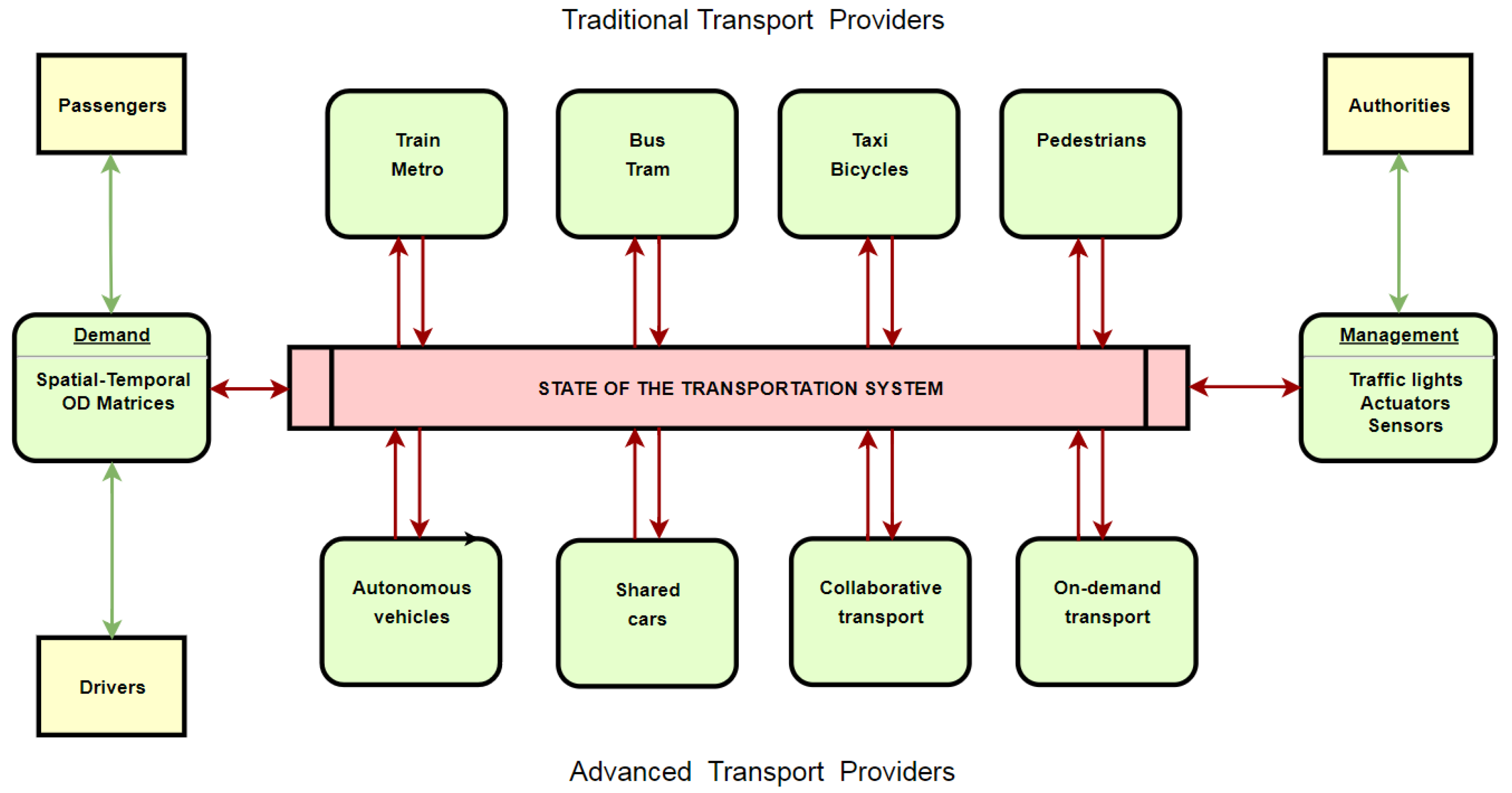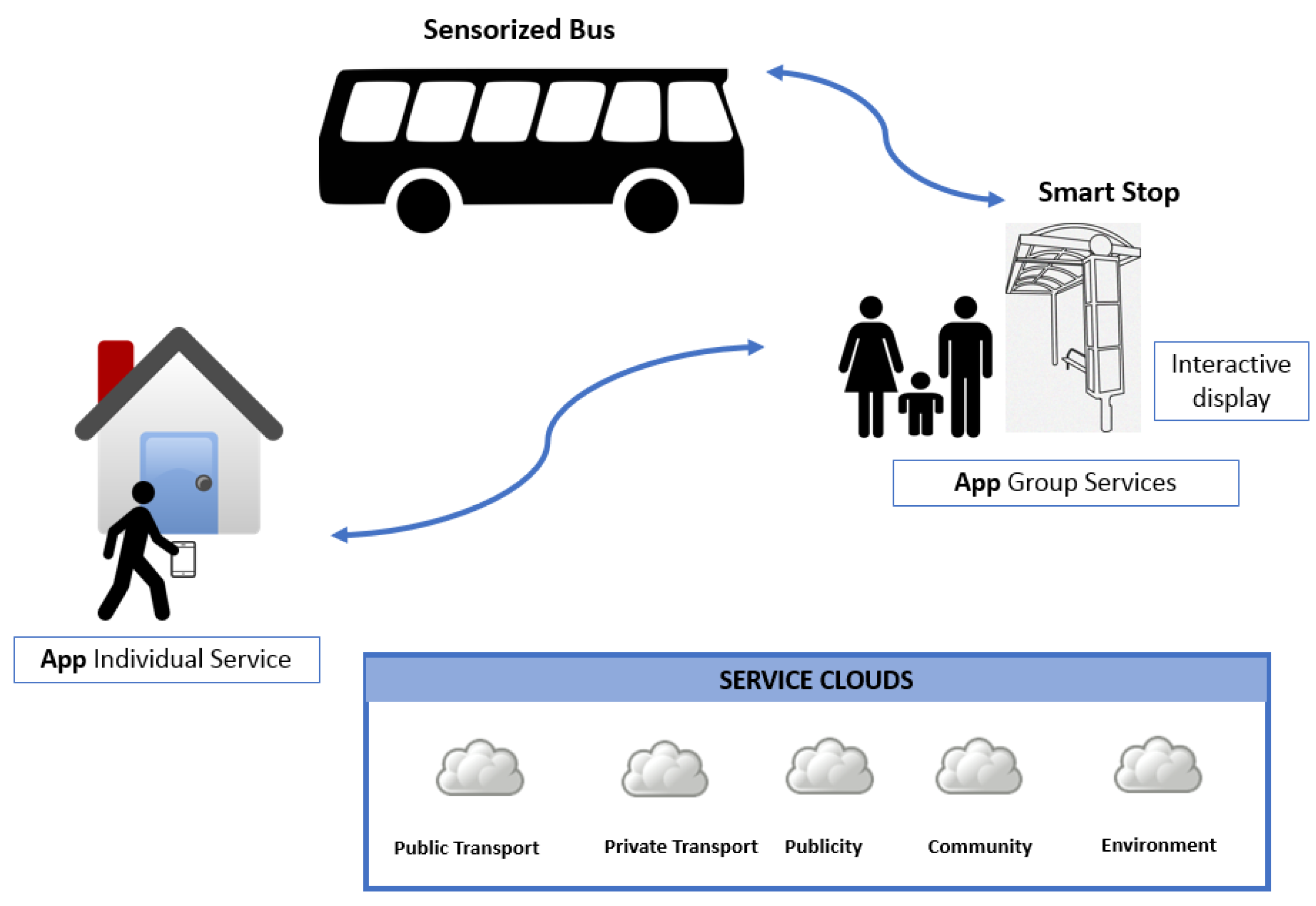MUSA–I. towards New Social Tools for Advanced Multi-Modal Transportation in Smart Cities †
Abstract
:1. Introduction
1.1. Towards New Social Tools for Advanced Transportation in Smart Cities
1.2. The Transport System
1.2.1. Transport Demand Modeling
- Trip-based model or classical four steps model [2] which estimates the number of trips for different travel modes and routes taken between any two origin and destination zones.
- Activity-based model, which predicts for each individual the desired number and sequence of activities and its required trips in a given time with a set of spatial, temporal and resources constraints. These individual activities are aggregated in origin-destination-matrices (OD data) for planning transport operations.
- Agent-based model. This method, founded on activity-based modelling, employs traffic simulation of agents for each individual demand, taking into account constraints of transport network [3]. Examples of agent-based tools are TRANSIM [4], SimAGENT [5], MATSim [6] and SimMobility [7]. These tools allow the modelling and analysis of time- and demand-dependent pricing, as well as new forms of mobility such as shared and autonomous vehicles.
1.2.2. Demand Modeling Data Sources
- Smart Card Automatic Fare Control (SC-AFC) data
- Smart phone and embedded GPS data
- Points of Interests (POI) information
- Census and Survey
- Land use information
1.3. State of the Transport System
2. Materials and Methods
3. Results
4. Discussion
5. Conclusions
Author Contributions
Funding
Acknowledgments
Conflicts of Interest
References
- Litman, T. Transportation Demand Management: Win-Win Solutions to Transport Problems. In Proceedings of the International Conference on Mobilty and Transport Transportation Demand Management (Insights from the Mobil. TUM 2012), München, Germany, June 2013. [Google Scholar]
- Fourie, P.J.; Erath, A.; Medina, S.A.O.; Chakirov, A.; Axhausen, K.W. Using Smartcard Data for Agent-Based Transport Simulation: The Case of Singapore; CRC Press: Boca Raton, FL, USA, 2016. [Google Scholar]
- Calabrese, F.; Ferrari, L.; Blondel, V.D. Urban sensing using mobile phone network data: A survey of research. ACM Comput. Surv. (CSUR) 2015, 47, 25. [Google Scholar] [CrossRef]
- Balmer, M.; Axhausen, K.; Nagel, K. Agent-based demand-modeling framework for large-scale microsimulations. Transp. Res. Rec. J. Transp. Res. Board 2006, 1985, 125–134. [Google Scholar] [CrossRef]
- Smith, L.; Beckman, R.J.; Anson, D.; Nagel, K.; Williams, M.E. TRANSIMS: Transportation ANalysis and SIMulation System. In Proceedings of the 5th TRB National Transportation Planning Methods Applications Conference, Seattle, WA, USA, April 1995. [Google Scholar]
- Goulias, K.G.; Bhat, C.R.; Pendyala, R.M.; Chen, Y.; Paleti, R.; Konduri, K.C.; Lei, T.; Tang, D.; Youn, S.Y.; Huang, G.; et al. Simulator of activities, greenhouse emissions, networks, and travel (SimAGENT) in Southern California. In Proceedings of the 91st Annual Meeting of the Transportation Research Board, Washington, DC, USA, 22–26 January 2012. [Google Scholar]
- Horni, A.; Nagel, K.; Axhausen, K. The Multi-Agent Transport Simulation MATSim; Ubiquity Press: London, UK, 2016. [Google Scholar]
- Adnan, M.; Pereira, F.C.; Azevedo, C.M.L.; Basak, K.; Lovric, M.; Raveau, S.; Zhu, Y.; Ferreira, J.; Zegras, C.; Ben-Akiva, M.E. SimMobility: A Multi-scale Integrated Agent-Based Simulation Platform. In Proceedings of the Transportation Research Board 95th Annual Meeting, Washington, DC, USA, 10–14 January 2016. [Google Scholar]
- Barry, J.; Newhouser, R.; Rahbee, A.; Sayeda, S. Origin and Destination Estimation in New York City with Automated Fare System Data. Transp. Res. Rec. J. Transp. Res. Board 2002, 1817, 183–187. [Google Scholar] [CrossRef]
- Trépanier, M.; Tranchant, N.; Chapleau, R. Individual Trip Destination Estimation in a Transit Smart Card Automated Fare Collection System. J. Intell. Transp. Syst. 2007, 11, 1–4. [Google Scholar] [CrossRef]
- Munizaga, M.A.; Palma, C. Estimation of a disaggregated multimodal public transport Origin–Destination matrix from passive smartcard data from Santiago, Chile. Transp. Res. Part C Emerg. Technol. 2012, 24, 9–18. [Google Scholar] [CrossRef]
- Yuan, N.J.; Wang, Y.; Zhang, F.; Xie, X.; Sun, G. Reconstructing Individual Mobility from Smart Card Transactions: A Space Alignment Approach. In Proceedings of the IEEE 13th International Conference on Data Mining (ICDM), Dallas, TX, USA, 7–10 December 2013. [Google Scholar]
- Devillaine, F.; Munizaga, M.; Trépanier, M. Detection of Activities of Public Transport Users by Analyzing Smart Card Data. Transp. Res. Rec. J. Transp. Res. Board 2012, 2276, 48–55. [Google Scholar] [CrossRef]
- Isaacman, S.; Becker, R.; Cáceres, R.; Kobourov, S.; Martonosi, M.M.; Rowland, J.; Varshavsky, A. Identifying Important Places in People’s Lives from Cellular Network Data. Pervasive Comput. 2011, 6696, 133–151. [Google Scholar]
- Bouman, P. Recognizing Demand Patterns from Smart Card Data for Agent-Based Micro- Simulation of Public Transport. Ph.D. Thesis, Erasmus University Rotterdam, Rotterdam, The Netherlands, 2012. [Google Scholar]
- Alexander, L.; Jiang, S.; Murga, M. Origin–destination trips by purpose and time of day inferred from mobile phone data. Transp. Res. Part C Emerg. Technol. 2015, 58, 240–250. [Google Scholar] [CrossRef]
- Jiang, S.; Ferreira, J., Jr.; González, M.C. Activity-Based Human Mobility Patterns Inferred from Mobile Phone Data: A Case Study of Singapore. IEEE Trans. Big Data 2015, 2, 208–219. [Google Scholar] [CrossRef]
- Yang, Y.; Widhalm, P.; Athavale, S.; González, M.C. Mobility Sequence Extraction and Labeling Using Sparse Cell Phone Data. In Proceedings of the Thirteen AAAI Conference on Artificial Intelligence (AAAI-16), Phoenix, AZ, USA, 12–17 February 2018. [Google Scholar]
- Wang, H.; Calabrese, H.F.; Lorenzo, G.D.; Ratti, C. Transportation mode inference from anonymized and aggregated mobile phone call detail records. In Proceedings of the 13th International IEEE Conference on Intelligent Transportation Systems, Madeira Island, Portugal, 19–22 September 2010. [Google Scholar]
- Pozdnoukhov, A. Activity Based Travel Demand Modelling with Cellular Data. 2015. Available online: http://www.ucconnect.berkeley.edu/workforce-development/ucconnect-transportation-planning-workshops/role-big-data-transportation (accessed on 15 May 2018).
- Noulas, A.; Mascolo, C. Exploiting foursquare and cellular data to infer user activity in urban environments. In Proceedings of the IEEE 14th International Conference on Mobile Data Management (MDM), Milan, Italy, 3–6 June 2013. [Google Scholar]
- Phithakkitnukoon, S.; Horanont, T.; di Lorenzo, G.; Shibasaki, R.; Ratti, C. Activity- aware map: Identifying human daily activity pattern using mobile phone data. In Human Behavior Understanding; Springer: Berlin/Heidelberg, Germany, 2010. [Google Scholar]
- Fu, Q.; Liu, R.; Hess, S.A. A review on transit assignment modelling approaches to congested networks: A new perspective. Procedia Soc. Behav. Sci. 2012, 54, 1145–1155. [Google Scholar] [CrossRef]
- Haar, H.S.; Simon, T. A Hybrid-Dynamical Model for Passenger-flow in Transportation Systems. In Proceedings of the 5th IFAC Conference on Analysis and Design of Hybrid Systems, Atlanta, GA, USA, 14–16 October 2015; Volume 48. [Google Scholar]
- Krishnamachari, B. Vehicular Sensing, Communication, and Green Transportation. 2015. Available online: http://imsc.usc.edu/retreat2015/presentations/slides_Bashkar.pdf (accessed on 20 April 2018).
- Wallbank, P. A Geek’s Tour of Barcelona. 2013. Available online: http://networkedglobe.com/2013/11/01/touring-barcelona-smart-city-internet-of-things/ (accessed on 15 May 2018).
- Ram, S.; Wang, Y.; Currim, F.; Dong, F.; Dantas, E.; Sabóia, L.A. SMARTBUS: A web application for smart urban mobility and transportation. In Proceedings of the 25th International Conference Companion on World Wide Web, Montreal, QC, Canada, 11–15 April 2016. [Google Scholar]
- Nikolaidou, A.; Papaioannou, P. Utilizing Social Media in Transport Planning and Public Transit Quality: Survey of Literature. J. Transp. Eng. 2018, 144, 04018007. [Google Scholar] [CrossRef]
- Anda, C.; Erath, A.; Fourie, P.J. Transport modelling in the age of big data. Int. J. Urban Sci. 2017, 21, 19–42. [Google Scholar] [CrossRef]
- Dibbelt, J.; Konstantopoulos, C.; Wagner, D.; Gavalas, D.; Kontogiannis, S.; Zaroliagis, C.; Pantziou, G. Multimodal route and tour planning in urban environments. In Proceedings of the 2017 IEEE Symposium on Computerss and Communications (ISCC), Heraklion, Greece, 3–7 July 2017. [Google Scholar]


Publisher’s Note: MDPI stays neutral with regard to jurisdictional claims in published maps and institutional affiliations. |
© 2018 by the authors. Licensee MDPI, Basel, Switzerland. This article is an open access article distributed under the terms and conditions of the Creative Commons Attribution (CC BY) license (https://creativecommons.org/licenses/by/4.0/).
Share and Cite
Nápoles, V.M.P.; Rodríguez, M.d.B.; Páez, D.G.; Penelas, J.L.E.; García-Ochoa, A.G.; Pérez, A.L. MUSA–I. towards New Social Tools for Advanced Multi-Modal Transportation in Smart Cities. Proceedings 2018, 2, 1215. https://doi.org/10.3390/proceedings2191215
Nápoles VMP, Rodríguez MdB, Páez DG, Penelas JLE, García-Ochoa AG, Pérez AL. MUSA–I. towards New Social Tools for Advanced Multi-Modal Transportation in Smart Cities. Proceedings. 2018; 2(19):1215. https://doi.org/10.3390/proceedings2191215
Chicago/Turabian StyleNápoles, Víctor Manuel Padrón, Manuel de Buenaga Rodríguez, Diego Gachet Páez, José Luis Esteban Penelas, Alba Gutiérrez García-Ochoa, and Alfonso López Pérez. 2018. "MUSA–I. towards New Social Tools for Advanced Multi-Modal Transportation in Smart Cities" Proceedings 2, no. 19: 1215. https://doi.org/10.3390/proceedings2191215
APA StyleNápoles, V. M. P., Rodríguez, M. d. B., Páez, D. G., Penelas, J. L. E., García-Ochoa, A. G., & Pérez, A. L. (2018). MUSA–I. towards New Social Tools for Advanced Multi-Modal Transportation in Smart Cities. Proceedings, 2(19), 1215. https://doi.org/10.3390/proceedings2191215




